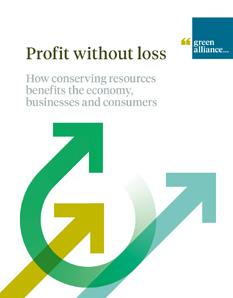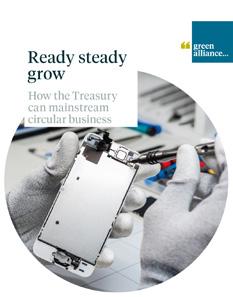Why a circular economy is good for business
“Creating a circular economy is the business opportunity of our time.”
Jan Jenisch, CEO, Holcim Ltd1

Why a circular economy is good for business
“Creating a circular economy is the business opportunity of our time.”
Jan Jenisch, CEO, Holcim Ltd1
In a circular economy, materials are highly valued, so are kept in use as long as possible, minimising the need to use more virgin resources with all the associated environmental impacts of extraction, processing, use and disposal.
But the reasons for ending the throwaway society are not just about the environment. By eliminating waste and promoting the repair, reuse, remanufacturing and high quality recycling of products, the government can meet wider economic goals.
The new government has stated an ambition to deliver a “decade of national renewal” for the UK, focusing on key missions, including growth, energy security and greater opportunities for all. Creating a circular economy should be at the heart of achieving these goals, as a source of job creation and to grow new industries.
By wholly embracing this approach, as countries like the Netherlands are already doing, the UK can enhance resource security, build its own lucrative reprocessing operations, upskill the workforce for high quality new jobs, including in the UK’s industrial heartlands. And, through the greater independence a circular economy brings, it would help to minimise the risks of volatile international supply chains, contributing to prosperity and economic stability.
To realise these benefits, a whole government approach is necessary, with all departments getting behind the mission to transform our unsustainable ‘take, make, waste’ economy into one that offers a more secure and prosperous future.
Materials and components are typically 40 to 60 per cent of manufacturing costs in Europe and can be up to 80 per cent of UK construction costs.2 Using materials more efficiently by improving resource productivity reduces input costs, increasing profits.
Our analysis has demonstrated the potential for resource efficiency in construction, where improving design practices could reduce materials by 22 per cent.3 For a project with 60 per cent material costs, this would cut costs by 13 per cent, potentially increasing profit.4
22 PER CENT REDUCTION IN MATERIAL USE
13 PER CENT REDUCTION IN 0VERALL COSTS
Valuable materials are being unnecessarily lost to the UK economy due to a lack of recovery, reuse and recycling facilities. Material Focus estimates that nearly £1 billion worth of precious metals in electronics are thrown away, stuck in household drawers, stolen or illegally exported from the UK.5 If valuable materials were instead recycled or reused in the UK it could reduce business costs by avoiding the need to import new materials.
There are new opportunities in capturing the value of secondary materials. Analysis for the Coalition for Wind Industry Circularity has shown that remanufacturing just ten wind turbine components with well established supply chains over the next ten years could create a UK market worth £9.6 billion.6
Remanufacturing wind turbine components could create a new UK market worth billions
Supply chain risks are a major concern. Disruption to maritime trade routes from climate change, Covid-19 and the war in Ukraine have all had a negative impact in recent years. According to a survey by The Economist of more than 400 US and European executives, over half of them (55 per cent) anticipated significant supply chain disruptions in 2024.7
This is compounded by increasing difficulties sourcing materials, with 91 per cent of more than 3,000 senior industrial decision makers in Europe, America and Asia saying they currently face challenges accessing raw materials, energy or labour.8 Circularity improves supply chain resilience by keeping materials and products in use for longer.
Nine out of ten industrialists in Europe, America and Asia have problems sourcing what they need
Consumers increasingly want to buy from companies with strong sustainability credentials. Adopting circular business models like reuse, repair and rental are important ways to reduce environmental impacts. UK polling in 2024 shows 82 per cent of people think brands should offer reuse and refill and reduce their packaging, and 71 per cent would view brands more favourably if they did.9 A 2021 survey found that 75 per cent of consumers in Europe are willing to pay more for sustainable products.10
Talent and skills are being attracted to companies viewed as environmentally sustainable. A 2022 survey by IBM showed that 67 per cent of people were more likely to apply for a job in companies they viewed as environmentally sustainable, and 68 per cent were more willing to accept an offer of a job from them. One in three who changed jobs recently accepted lower pay to work for a sustainable organisation.11
82% want more reuse and re ll 71% would view brands favourably if they o ered more reuse
75% would pay more for sustainable products
More and more businesses are committing to net zero.
Over 4,000 have signed up to the Science Based Targets initiative (SBTi). Achieving these targets means tackling emissions throughout supply chains, which come from “the extraction and transformation of raw materials, to the manufacturing, logistics, distribution, use and end-of-life of products”.12 These emissions account for over 70 per cent of a company’s carbon footprint on average.13
Using fewer materials, and reusing and remanufacturing components and equipment, can drastically cut emissions. For example, refurbished electronic equipment can save almost 100 per cent of emissions compared to buying new.14
Goods and services bought are the biggest source of a company’s climate impact15,16
Two thirds of one construction company’s emissions
Facilities, vehicles and purchased power
Other upstream like transport and waste
60% of one fashion company’s emissions
Facilities, vehicles and purchased power
Other
Goods and services bought
Goods and services bought
Use of sold products
What the government should do
The new government has announced a time limited taskforce to create a circular economy strategy for England. This is a positive step towards unlocking these benefits. Here are three actions that will ensure it makes the most of the opportunity:
1. Embed cross government action on resources
A new approach to resources requires effort right across government. The new taskforce will report to a small ministerial group, including the Treasury, environment, energy, transport, housing and business departments.
Long term success will depend on all these departments promoting and adopting circular economy approaches.
Reboot the UK’s resources plan
Care is needed to avoid pitfalls encountered by previous administrations. The promised strategy should include concrete measures, including specific plans for high
impact sectors like construction, electronics, batteries, textiles and food, and mechanisms for improving data, including the long promised National Materials Datahub. Economic incentives should align with the circular economy objective. Higher product standards should be adopted, with a more ambitious approach to extended producer responsibility, focused on reuse and reduction.
3. Set a national resource reduction target
The UK’s material footprint, which measures the virgin resources extracted to meet demand for products and services, is rising and, at 16.5 tonnes per person per year, it is over twice the UN’s suggested sustainable range of six to eight tonnes per person per year.17
The north star of a new approach should be a national resource reduction target, along the lines of emissions reduction targets, providing a guiding framework for policy that brings resource use in line with what science says is needed. This was supported by the Labour Party in opposition and now, in government, it should introduce it using existing powers through the Environment Act 2021.18










1 J Jenisch, 24 May 2024, ‘Why the circular economy is the business opportunity of our time’, World Economic Forum website
2 Estimates of material costs vary. Bridgit suggests 60-80 per cent of project costs, see: Bridgit, ‘Labor vs material cost in construction: 6 things to keep in mind’ https:// gobridgit.com/blog/labor-vsmaterial-cost-in-construction-6things-to-keep-in-mind/; Trackunit suggests 30-40 per cent of project costs, see: Trackunit, 1 July 2024, ‘Construction project cost breakdown: estimate the total cost’; Business in the Community (BiTC) suggests 40-60 per cent for manufacturing in Europe, see: BiTC, 2021, Smart growth: the economic case for the circular economy.
3 Green Alliance, 2022, Circular construction: building for a greener UK economy
4 Analysis based on a 22 per cent reduction in material requirements, modelled as part of the analysis for Green Alliance, 2022a, Circular construction: building for a greener UK economy, and an assumed 40-60 per cent material cost, as a central estimate based on sources in endnote 3.
5 Material Focus, 28 March 2024, ‘Nearly £1 billion worth of precious materials could be saved if all our electricals were recycled’
6 BVG Associates, 18 May 2023, ‘Maximising circularity in the wind industry’
7 Economist Impact, 2024, Next gen supply chains
8 ABB Group, 2024, Circularity: no time to waste
9 City to Sea, March 2024, Attitudes towards reuse and refill in the UK
10 Bain & Company, 4 October 2021, ‘One more reason to get sustainable brands right’
11 ESG Today, 18 April 2022, ‘IBM survey: employees more likely to accept jobs from sustainable companies’
12 Science Based Targets initiative, 20 February 2023, ‘Scope 3: stepping up science-based action’
13 Ibid
14 Green Alliance, 2022b, Circular business: what companies need to make the switch
15 Adapted from: Green Alliance, 2022b, op cit. Note that the construction company’s emissions profile does not include downstream emissions from the use of buildings.
16 Ibid
17 Green Alliance, 2024, Measuring up: the potential of targets to reduce resource use
18 Hansard, ‘Record of delegated legislation committee debate on draft environmental targets regulations 2022’: debated Monday 23 January 2023
19 As quoted in Green Alliance, 2023, Ready steady grow: how the Treasury can mainstream circular business
“The business case is clear from an economic point of view in that you’re fundamentally turning waste into profit.”
Richard Kenny, group sustainability director, Techbuyer19
Green Alliance
18th Floor
Millbank Tower
21-24 Millbank
London SW1P 4QP
020 7233 7433
ga@green-alliance.org.uk
www.green-alliance.org.uk
@GreenAllianceUK
blog: www.greenallianceblog.org.uk
Authors Heather Plumpton, Emily Carr and Libby Peake
Acknowledgements
This is produced by Green Alliance as part of a work programme for the Circular Economy Task Force, a policy focused business forum to promote ambitious ideas on the better management of resources.
The analysis and recommendations presented here are solely those of Green Alliance and do not necessarily reflect the views of the Circular Economy Task Force members. Task force members include:




With support from:

Green Alliance
Green Alliance is an independent think tank and charity focused on ambitious leadership for the environment. Since 1979, we have been working with the most influential leaders in business, NGOs and politics to accelerate political action and create transformative policy for a green and prosperous UK.
The Green Alliance Trust Registered charity no 1045395 Company limited by guarantee (England and Wales) no. 3037633
Published by Green Alliance November 2024
Designed by Howdy
© Green Alliance, November 2024
Text and original graphics in this work are licensed under the terms of the Creative Commons Attribution License which permits unrestricted use, provided we are credited as the original author and source. Details of the license are available at: creativecommons.org/licenses/by/4.0. Photographic images are subject to copyright and are not covered by this license.

